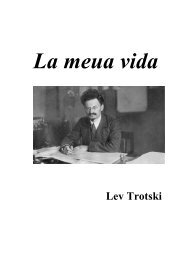The Communist Manifesto
The Communist Manifesto
The Communist Manifesto
You also want an ePaper? Increase the reach of your titles
YUMPU automatically turns print PDFs into web optimized ePapers that Google loves.
Capital Volume I. <strong>The</strong> Commodity 43represents the exchange value of one quarter of wheat, x blacking, y silk, z gold, &c., must, asexchange values, be replaceable by each other, or equal to each other. <strong>The</strong>refore, first: the validexchange values of a given commodity express something equal; secondly, exchange value,generally, is only the mode of expression, the phenomenal form, of something contained in it,yet distinguishable from it.Let us take two commodities, e.g., corn and iron. <strong>The</strong> proportions in which they areexchangeable, whatever those proportions may be, can always be represented by an equation inwhich a given quantity of corn is equated to some quantity of iron: e.g., 1 quarter corn = x cwt.iron. What does this equation tell us? It tells us that in two different things – in 1 quarter of cornand x cwt. of iron, there exists in equal quantities something common to both. <strong>The</strong> two thingsmust therefore be equal to a third, which in itself is neither the one nor the other. Each of them,so far as it is exchange value, must therefore be reducible to this third.A simple geometrical illustration will make this clear. In order to calculate and compare theareas of rectilinear figures, we decompose them into triangles. But the area of the triangle itselfis expressed by something totally different from its visible figure, namely, by half the product ofthe base multiplied by the altitude. In the same way the exchange values of commodities mustbe capable of being expressed in terms of something common to them all, of which thing theyrepresent a greater or less quantity.This common “something” cannot be either a geometrical, a chemical, or any other naturalproperty of commodities. Such properties claim our attention only in so far as they affect theutility of those commodities, make them use values. But the exchange of commodities isevidently an act characterised by a total abstraction from use value. <strong>The</strong>n one use value is just asgood as another, provided only it be present in sufficient quantity. Or, as old Barbon says, “onesort of wares are as good as another, if the values be equal. <strong>The</strong>re is no difference or distinctionin things of equal value ... An hundred pounds’ worth of lead or iron, is of as great value as onehundred pounds’ worth of silver or gold.”As use values, commodities are, above all, of different qualities, but as exchange values they aremerely different quantities, and consequently do not contain an atom of use value.If then we leave out of consideration the use value of commodities, they have only one commonproperty left, that of being products of labour. But even the product of labour itself hasundergone a change in our hands. If we make abstraction from its use value, we makeabstraction at the same time from the material elements and shapes that make the product a usevalue; we see in it no longer a table, a house, yarn, or any other useful thing. Its existence as amaterial thing is put out of sight. Neither can it any longer be regarded as the product of thelabour of the joiner, the mason, the spinner, or of any other definite kind of productive labour.Along with the useful qualities of the products themselves, we put out of sight both the usefulcharacter of the various kinds of labour embodied in them, and the concrete forms of thatlabour; there is nothing left but what is common to them all; all are reduced to one and the samesort of labour, human labour in the abstract.Let us now consider the residue of each of these products; it consists of the same unsubstantialreality in each, a mere congelation of homogeneous human labour, of labour power expendedwithout regard to the mode of its expenditure. All that these things now tell us is, that humanlabour power has been expended in their production, that human labour is embodied in them.When looked at as crystals of this social substance, common to them all, they are – Values.We have seen that when commodities are exchanged, their exchange value manifests itself assomething totally independent of their use value. But if we abstract from their use value, thereremains their Value as defined above. <strong>The</strong>refore, the common substance that manifests itself inthe exchange value of commodities, whenever they are exchanged, is their value. <strong>The</strong> progressof our investigation will show that exchange value is the only form in which the value ofcommodities can manifest itself or be expressed. For the present, however, we have to considerthe nature of value independently of this, its form.A use value, or useful article, therefore, has value only because human labour in the abstract hasbeen embodied or materialised in it. How, then, is the magnitude of this value to be measured?Plainly, by the quantity of the value-creating substance, the labour, contained in the article. <strong>The</strong>


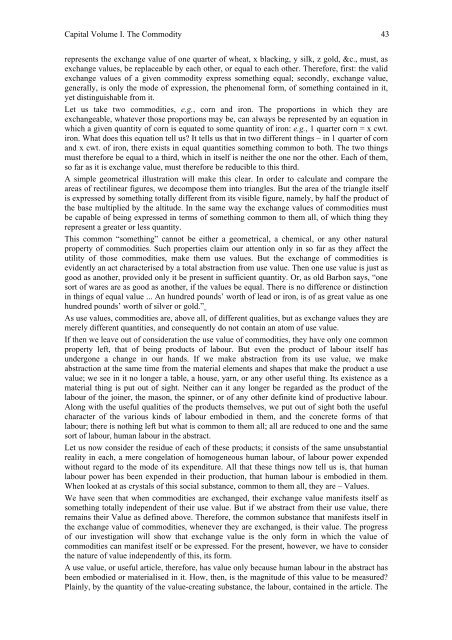
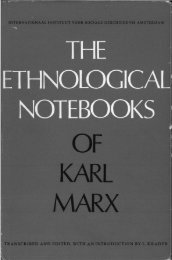
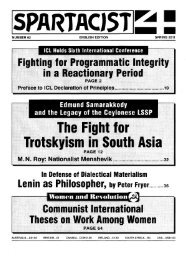

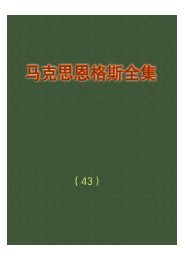
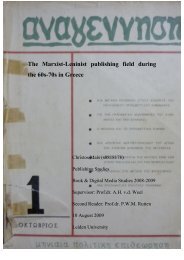

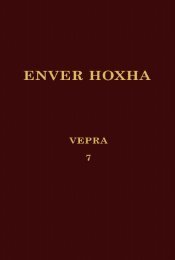
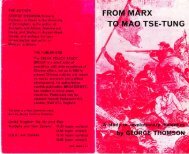

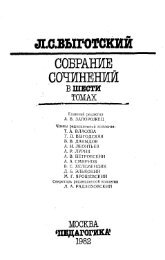
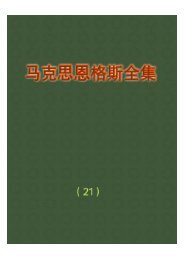
![tyf Enf=O=n]lgg](https://img.yumpu.com/47584932/1/190x245/tyf-enfonlgg.jpg?quality=85)
